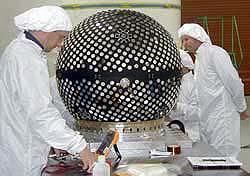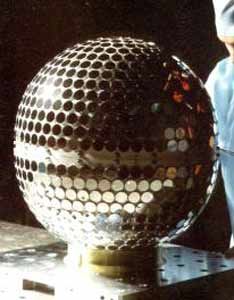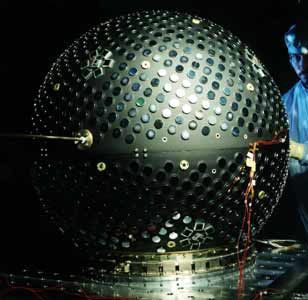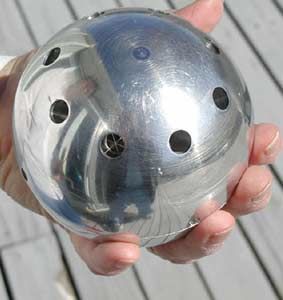
Home - Search - Browse - Alphabetic Index: 0- 1- 2- 3- 4- 5- 6- 7- 8- 9
A- B- C- D- E- F- G- H- I- J- K- L- M- N- O- P- Q- R- S- T- U- V- W- X- Y- Z
Starshine
 Starshine |
Status: Operational 1999. First Launch: 1999-05-27. Last Launch: 2001-09-30. Number: 2 . Gross mass: 39 kg (85 lb).
More at: Starshine.
| Starshine 3 (Starshine-OSCAR 43, SO 43) Null |
Family: Earth, Technology, Technology satellite. Country: USA. Spacecraft: ISS, Athena Mars Flyby. Launch Vehicles: Space Shuttle, Athena-1. Launch Sites: Cape Canaveral, Cape Canaveral LC39B, Kodiak. Agency: NASA Greenbelt. Bibliography: 2, 296, 4, 6944, 13219.
 | Starshine 1 Credit: Manufacturer Image |
 | Starshine 3 Credit: Manufacturer Image |
 | Starshine 5 Credit: Manufacturer Image |
1999 May 27 - . 10:49 GMT - . Launch Site: Cape Canaveral. Launch Complex: Cape Canaveral LC39B. Launch Platform: MLP2. LV Family: Shuttle. Launch Vehicle: Space Shuttle.
- Starshine - .
Nation: USA.
Agency: NASA Greenbelt.
Program: ISS.
Class: Technology.
Type: Navigation technology satellite. Spacecraft: Starshine.
Decay Date: 2000-02-18 . USAF Sat Cat: 25769 . COSPAR: 1999-030B. Apogee: 324 km (201 mi). Perigee: 311 km (193 mi). Inclination: 51.60 deg.
At 0:721 GMT on June 5 the Starshine satellite was ejected into a 379 x 396 km x 51.6 degree orbit from a canister at the rear of STS-96 Space Shuttle Discovery's payload bay. The small Starshine satellite, built by NRL, was to be observed by students as part of an educational exercise.
2001 September 30 - . 02:40 GMT - . Launch Site: Kodiak. LV Family: Athena. Launch Vehicle: Athena-1.
- Starshine 3 - .
Mass: 67 kg (147 lb). Nation: USA.
Agency: USAF.
Class: Earth.
Type: Geodetic satellite. Spacecraft: Starshine.
Decay Date: 2003-01-21 . USAF Sat Cat: 26929 . COSPAR: 2001-043A. Apogee: 472 km (293 mi). Perigee: 472 km (293 mi). Inclination: 67.00 deg.
Possibly last Athena flight. Launch delayed from September 1, 18, 22, 23, 25, 28. This was the first orbital launch from Alaska's Kodiak Island launch site (Foul weather and auroral conditions had delayed the launch many times) . The Lockheed Martin Athena-1's Orbit Adjust Module's (OAM) four MR-107 hydrazine engines fired for 12 minutes to put the payloads in a 237 x 815 km transfer orbit. After a coast to apogee above East Africa, a second burn at 0337 GMT circularized the orbit. USAF Space Test Program satellites Picosat, Sapphire and PCSat were deployed into an 790 x 800 km x 67 deg orbit between 0344 and 0352 GMT; the OAM then made a perigee lowering burn to a 470 x 800 km orbit. Another burn half an orbit later put OAM in a 467 x 474 km orbit, from wish Starshine 3 was deployed. Finally, the OAM made a perigee-lowering depletion burn which left in a 215 x 403 km x 67.2 deg orbit from which would reenter in a few months.
Starshine-3 was a 90 kg, 0.9 m geodetic sphere that was to be observed by students. The NASA satellite was basically a passive light-reflecting sphere, consisting of 1,500 student-built mirrors (polished by kindergarten and grade school students from many countries) and 31 laser "retroreflectors". A few solar cells provide enough power to send a beacon at 145.825 MHz every minute. Ham operators around the world were expected to obtain signal strengths from which the decay (due to magnetic torque) of its spin rate could be determined. The project was managed by NASA GSFC and Starshine was built by the Naval Research Laboratory.
2002 April 26 - .
2003 January 21 - .
Back to top of page
Home - Search - Browse - Alphabetic Index: 0- 1- 2- 3- 4- 5- 6- 7- 8- 9
A- B- C- D- E- F- G- H- I- J- K- L- M- N- O- P- Q- R- S- T- U- V- W- X- Y- Z
© 1997-2019 Mark Wade - Contact
© / Conditions for Use